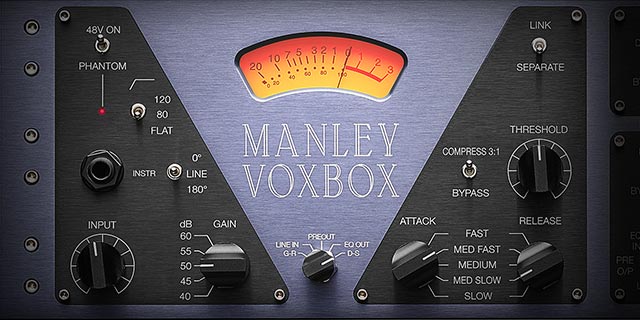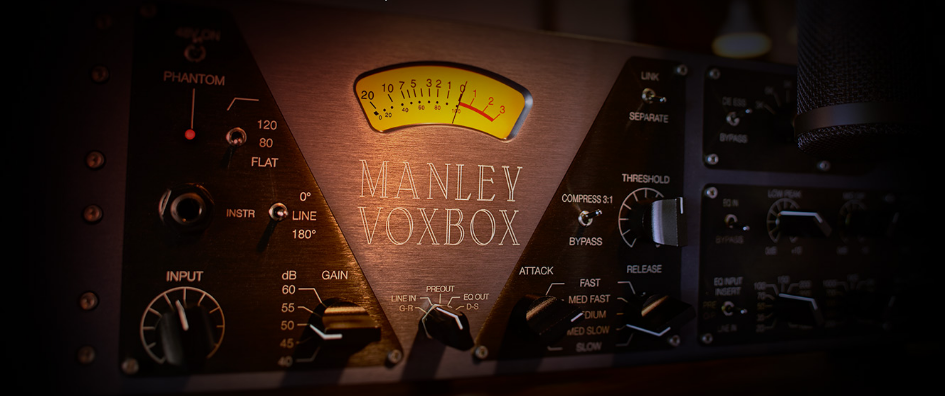New Software Review: Manley VOXBOX Channel Strip from Universal Audio

Despite its name, the VOXBOX is much more than just a vocal processor—it can impart the thick and rich sonic footprint Manley is known for on sound sources of all kinds.
One of Universal Audio’s latest offerings is a software emulation of the Manley VOXBOX channel strip.
While many of the brand’s plugins are based on classic historical pieces of gear, the VOXBOX is comparatively new to the hardware scene. Many recordists love the sound of tubes and how they saturate. Let’s see how this plugin stacks up.
Features
Manley is all about tubes and known for a particular sound. This is not a transparent piece of gear; it has a definite footprint. The VOXBOX is a full-fledged channel strip, including a microphone preamp, electro-optical compressor/limiter, de-esser, and a three-band equalizer.
There are any number of channel strips out there, but I find this one to be unique for several reasons. It has a flexible workflow, but it is not the easiest piece of gear to figure out. In other words, the control layout from left to right is not how the signal flows. This is exactly like the real model. As many have said, and my personal motto, RTFM.
The VOXBOX can accept mic, line, or instrument level signals via your Apollo interface. The first controls we encounter are polarity, and a 6dB/octave high-pass filter that offers flat, 80Hz, or 120Hz cutoff points.
The next control is the input level. In an interesting twist, this level control feeds into the compressor. Even mic signals hit the compressor before the preamp. According to Manley, this is useful for minimizing distortion. This makes sense… by constraining the signal, it’s less likely to overload the next stage, or at the very least, let you decide how and when to saturate. Since it’s based on a passive resistor circuit, it also keeps the tone of the tube mic pre intact.
The compressor doesn’t have the standard make-up gain control, but rather input, threshold, and output levels. The compressor uses a 3:1 fixed ratio, but it is somewhat dependent on the program material. Attack and Release each offer 5 speed choices, giving us a total of 25 different combinations.
Since this device is based on an optical resistor, even the fastest setting isn’t very fast. However, slower optical circuits tend to sound smoother and more natural. If you need something fast and grabby, this is not the compressor to use. Stereo instances offer a link control to ensure the stereo field doesn’t shift, or you can choose to keep them separate to allow for more definition and width.
After the compressor is the mic pre section. Our only control here is gain, and it offers between 40 and 60dB. It is a different control than most mic preamps in that gain here affects the negative feedback of the amp. The amount of negative feedback affects the transients, harmonic distortion, tone and clipping level. This functions more as a tone control rather than level.
Next in the signal flow is the equalizer, which is based off the Pultec MEQ equalizer. It offers us low-peak, mid-dip, and high-peak bands. The high and low bands offer 11 selectable frequencies, while the mid band offers 10 choices. Each band offers 10dB of gain.
Following the equalizer is an interesting control that can be used as a de-esser, or a 10:1 limiter. The de-esser offers 4 different center frequency options. A flexible VU meter can show gain reduction, line input level, and output levels after the preamp, EQ, and de-esser, each selectable via a detented pot. Last in our signal flow is the output transformer and output level control. Each of the processors listed above, including the transformer, have a bypass setting.
In Use
The VOXBOX is an interesting piece of gear. Signal flow and controls are different than many other similarly-equipped channel strips, so the learning curve may be steep. This is true for the hardware unit as well. That being said, there are plenty of options and lots of room for control over your sound. Exploration and persistence will be rewarded here.
The sound, while specific, can be great on many sources. And even though the name refers to vocals, this tool shouldn’t be limited to that. I had particularly good luck on keys and a soft, nasal voice was rendered thick and prominent. This is not a do-it-all device, but then again, the name pretty much tells you what its intended purpose is.
In practice, the compressor circuit was useful for dialing in the right amount of gain reduction, and the stepped attack/release choices should be sufficient for most tracking purposes. The EQ is for broad tonal shaping, and not intended for surgical work. The VOXBOX is not a mixdown Swiss Army Knife-style problem solver. However, for tracking and rendering voices and instruments in big, bold tube style, it excels. Weaker, thinner sounds can easily be beefed up and given that much-needed girth.

Like all plugins that are part of the UAD-2 platform, the VOXBOX features UA’s “Unison” technology, providing users true replication of the gain staging, impedance, and all-around circuit behaviors found in the original hardware units.
One final comment about plugins that feature UA’s “Unison” technology: While this plugin can be used on any track, at any time, the real power of the emulation lies in the input section of the Apollo. Unison technology essentially adapts the input to match the physical characteristics and attributes of whatever piece they are emulating. Specifically, this really applies to impedance.
The relationship of the output impedance of one device (mic or instrument) to the input impedance of the next device (preamp) makes up a huge portion of a given sound. Any two pieces of gear that are connected affect each other in their interactions, and capturing the authentic tone of any plugin that uses Unison requires tracking through it from the start.
To Be Critical
The VOXBOX is not of the easy-to-use/one-setting-fits-a
While offering a full-fledged channel strip worth of processing power, the fixed-ratio compressor, and limited de-essing frequencies will not solve every problem. The Pulteq-style EQ is musical, but not surgical, and limited in gain.
Additionally, the Manley tube tone is a well-defined, and very specific type of sound, which may be too slow, thick, and gooey for some source material. This plugin is fantastic for enhancing and elevating the quality of your source material, but as a problem solver, it is lacking. These are not necessarily harsh critiques though, as the VOXBOX can sound absolutely luxurious.
Summing it Up
If you’re in need of a Swiss Army knife channel strip, I would look somewhere else before the UA VOXBOX. However, if you want to grab the classy, thick tube sound of the original Manley VOXBOX, for a small portion of the cost of the hardware ($299), this emulation may be perfect for you.
While the name hints at vocal usage, I also found the VOXBOX to be useful for keys, guitars, and bass that needed some hi-fi sheen.
The Universal Audio plugins are all DSP-based, meaning there is a finite amount of processing power depending on your hardware. Users of the Apollo SOLO or DUO who wish to process and commit to sounds as much as possible (like our ancestors), and save DSP for other processing at mixdown would also be well served by this plugin.
Please note: When you buy products through links on this page, we may earn an affiliate commission.






